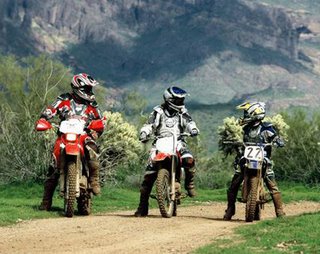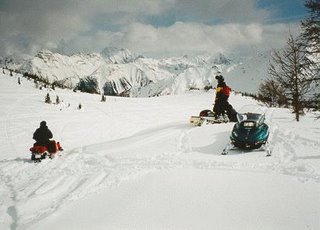
Tuesday, May 5, 2009

In the winter, more layers are appropriate, but NEVER wear a loose scarf when riding an OHV. Snowmobile suits are ideas for OHV. Special riding gear such as chest protectors, pants with knee pads and shin guards, and jacks with special pading can provide additional protection.
The nature of off-highway vehcile (OHV) riding makes it essential that riders wear protective clothing:
- Helmet - A helmet is the single most important piece of protection that can be worn.
- Eye protection - Always wear goggles or a bubble visor shield.
- Gloves - A good pair of gloves is essential.
- Boots - It is important to have a pair of strong, over-the-ankle boots, with heels.
- Shirt or jacket - You need to wear a long-sleeved shirt or jacket when riding.
- Pants - You need to wear long pants to protect your legs.
Review this checklist before you ride to ensure a safe trip.
- Notify someone of where you intend to ride and what time you wil return. Never ride alone.
- Check that your OHV is in proper working condition; all fluids are topped off; there are no loose or broken parts; and that your spark arrestor is in good condition and has not been modified.
- Carry basic tools and survival gear, including plenty of drinking water.
- Make sure you have proper riding gear for the route planned, including at the very least a helmet, sturdy over-the-ankle boots, gloves, and eye protection.
- If riding in an unfamiliar area, make sure you have checked with the managing owner or agency to verify the area is open for OHV use. Be sure you have a current travel plan map.
- Make sure your OHV is clean and free of weed seeds.
- Be sober.
- Be mentally and physically prepared for your ride.
Posted by Futurecamping
| Post a Comment
|
0
comments
|
![]()
Sunday, May 3, 2009

- Know your abilities and your snowmobile's capabilities and don't go beyond them.
- Know your riding area. Get a map. Talk to the local snowmobilers.
- Check local weather forecasts and plan for unexpected conditions.
- Maintain your snowmobile in top form for a dependable ride.
- Cross roads carefully. Come to a complete stop and make sure no traffic is approaching from any direction. Then cross at a right angle to the road.
- Dress for changing weather conditions. Wear layers of clothing so you can add or remove clothing as needed. Always wear a helmet.
- Plan for the unexpected by carrying a tool kit, first aid kit and survival items. Let someone know your plans so searchers will know where to look if you are lost or overdue.
- Never ride alone. Small problems can become big problems when riding alone.
- Check ice conditions before traveling on frozen lakes or rivers.
- Learn to recognize avalanche areas and avoid them. Carry avalanche rescue equipment including a transceiver, probe pole and shovel, and know how to use them. Review the local avalanche advisory when available.
- Ride sober. Alcohol increases the chance of frostbite and hypothermia, and affects the skills you need to ride safely.
- Operate at safe speeds and be prepared to stop within your line of sight. Slow down and enjoy the ride.
- Beware of darkness. Low light and darkness require special care. Slow down. Don't over-drive your headlights. Ask yourself, "Am I driving slow enough to see an object in time to avoid a collision?" At night on lakes and large open fields, estimating distances and direction of travel may become difficult.
- Stay alert. Avoid focusing on the tail light of the snowmobile ahead of you; scan ahead and alongside your path of travel and those you are following. Reaction times slow when you are tired. Be aware that even though you may not feel tired, the motion, darkness, wind, and vibration of the machine may begin to dull your senses.
- Use basic hand signals. Other snowmobilers and car drivers need to know what you're up to:
- Left turn: left arm extended straight out
- Right turn: left arm out, forearm raised, with elbow at 90-degree angle
- Stop: left arm raised straight up
- Slow: left arm out and angled toward the ground
Posted by Futurecamping
| Post a Comment
|
0
comments
|
![]()